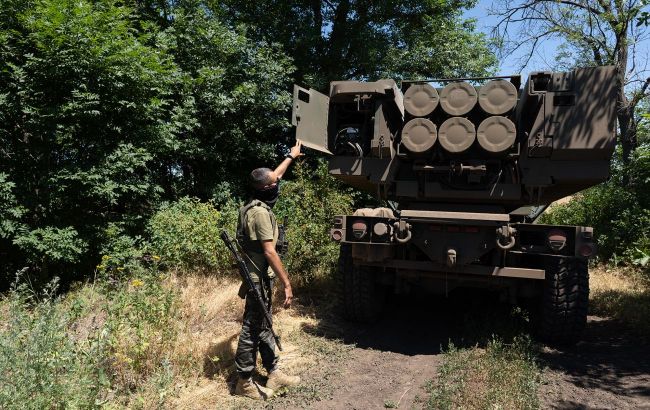'Belgorod region is just beginning': How strikes with US weapons on Russian territory will help Ukraine at front
 Photo: Ukrainian military was allowed to fire HIMARS on the territory of Russia (GettyImages)
Photo: Ukrainian military was allowed to fire HIMARS on the territory of Russia (GettyImages)
US President Joe Biden has allowed Ukraine to strike Russian territory with American weapons. According to Western media, the first strikes could begin within a few hours or days.
RBC-Ukraine explored what this decision by a key ally means and what opportunities it opens up.
Contents
- There's a green light with limitations: What is known
- Ukraine's use of American weapons against Russia
- Will the Ukrainian Armed Forces be able to drive out Russian troops from the northern part of the Kharkiv region
- Will the US continue to lift restrictions
- How Russia reacts and why 'it will be easier later'
There's a green light with limitations: What is known
Biden agreed under pressure from his advisors and allies, The New York Times reports. The American president has allowed limited strikes on the territory of a country that possesses nuclear weapons for the first time. However, the White House emphasizes that this pertains to acts of self-defense, allowing Ukraine to defend Kharkiv from cruise missiles, rockets, and artillery.
"Recently, the president instructed his team to ensure that US weapons could be used for counterfire in Kharkiv so that Ukraine could retaliate against Russian forces that are striking or preparing to strike," one official noted.
Changes in Washington's policy took effect on Thursday, May 30. It is specified that the ban on long-range ATACMS missiles remains in effect.
Ukrainian President Volodymyr Zelenskyy confirmed a positive message from the American side. He added that he cannot disclose details, but the US decision is a step forward and an opportunity to protect residents of border areas.
As highlighted in The Guardian, strikes could target military forces and command centers in the region bordering the Kharkiv region. The first attacks are expected within hours or days.
Oleksandr Musiienko, the head of the Center for Military-Political Studies, concludes that we will soon see significant strikes on the Belgorod region.
"In fact, the process of providing assistance has begun so that we can strike at the concentration of Russian troops. They are currently forming grouping for further advancement into the Kharkiv region," he told RBC-Ukraine.
Ukraine's use of American weapons against Russia
Military expert Vladyslav Seleznov also anticipates strikes on targets, at least within the territory of the Belgorod region.
"This is indeed very important. Starting from aircraft launching guided aerial bombs (KABs) from there, and ending with missile complexes like Iskander-K, Iskander-M, and S-300/S-400 launchers. We must destroy enemy targets because it's legitimate," he emphasized in an interview with RBC-Ukraine.
Moreover, now that Ukrainian intelligence clearly knows where enemy troops and equipment are concentrated, there is the right, within the framework of preventive measures, to strike with American weapons. "The occupiers behave too brazenly just a few kilometers from the border, constantly employing artillery, mortars, missiles, and KABs," he added.
According to him, there is an opportunity to apply a wide range of armaments. For example, using HIMARS MLRS against troops, equipment, and missile complexes, as well as using the Patriot air defense system against aerial targets over the Belgorod region.
As for ATACMS, there is no direct prohibition, there are certain recommendations, but they are unlikely to last long, Musiienko believes.
"The defense forces will target ATACMS, especially with cluster munitions, which have a range of 160 km and are effective against enemy troops. Besides HIMARS, there is another artillery capable of reaching Russian units 10-15 km from the border," the expert added.
Will the Ukrainian Armed Forces be able to drive out Russian troops from the northern part of the Kharkiv region
Interlocutors of RBC-Ukraine are cautious in their forecasts regarding whether it will be possible to drive out Russians from the northern part of the Kharkiv region in this way. According to Musiienko, there will be two priority goals.
"The first one is not to allow the strengthening of the enemy's grouping and the expansion of the front line. Because from the Hraivoron area, the Russians can move to Sumy or to Bohodukhiv (the Kharkiv region). And also not to allow the possibility of reinforcement in the area of Vovchansk, where the nature of their actions suggests that there may not be direct battles in the city itself, but flanking maneuvers. The second one is not to allow the support of the contingent already present in the Kharkiv region," he explains.
Vladyslav Seleznov emphasizes that the situation here is stabilized. But the opponent is replenishing assault units and transferring parts of the 44th Army Corps from the Kursk region. To attempt another advance in the area of Lyptsi or Vovchansk.
"It's not worth hoping that the enemy will show 'goodwill' (after strikes with Western weapons - Ed.). I have no illusions because the enemy clearly carries out tasks regarding the sanitary zone and creating threats to Kharkiv and our forces in the Kupiansk direction," the expert said.
Will the US continue to lift restrictions
The consequences of the American decision could be much broader. The Biden administration acknowledges that if Russia expands its offensive beyond the Kharkiv region, more restrictions will be lifted.
"This is a new reality. And perhaps a new era," quotes the NYT one of the high-ranking officials.
According to Seleznov, threats exist not only from the Belgorod region but also from the Kursk and Bryansk regions. Therefore, the next stage could be permission to use American and other Western weapons in these regions.
"I have noted for myself that the change in US policy is driven by the supply of certain components from China to the Russian army. Thus, a transformation is taking place to provide Ukraine with at least parity on the battlefield," he believes.
He also noted that Russia is not ready for negotiations, insists on ultimatums, and understands only force. And this means that Ukraine, besides weapons itself, needs corresponding rights to its use.
How Russia reacts and why 'it will be easier later'
Meanwhile, Western media anticipate the reaction from the Russian side. Earlier, Russia conducted exercises deploying tactical nuclear forces, but Moscow has repeatedly played the nuclear card. It's difficult to say where Vladimir Putin will draw a new red line now, as there hasn't been a clear response to the UK's allowance of striking with Storm Shadow missiles, according to NYT.
It's worth noting that in recent days, other allies have supported London's position. More details on this can be found in the material Which NATO countries support Ukraine's strikes on Russia.
Today, Russia's Deputy Security Council Chief Dmitry Medvedev threatened nuclear war not only against Ukraine but also against NATO countries. However, the Russian rhetoric with arguments to "turn the whole world into nuclear ash" is not new and will not compel partners to reconsider permits for weapons, Seleznov believes.
"A dog that barks a lot usually doesn't bite. I think all these statements are purely provocative. Russia won't dare to use nuclear weapons. It understands the fatal consequences. Putin cannot have illusions; the Russian potential cannot be compared to NATO's. And this means that Russia is doomed to defeat, even if it opens the nuclear Pandora's box," he told RBC-Ukraine.
According to Oleksandr Musiienko, we are only witnessing the first steps. And in the future, the Ukrainian Armed Forces will be able to strike with Western weapons not only in the Belgorod region.
"It will be easier later. The Americans will look at Russia's reaction, see that everything is fine, and there's no need to expect anything that hasn't happened before. So, I think the Belgorod region is just the beginning," concluded the interlocutor.
Sources: articles from The New York Times, The Guardian, comments from experts Vladyslav Seleznov and Oleksandr Musiienko.

